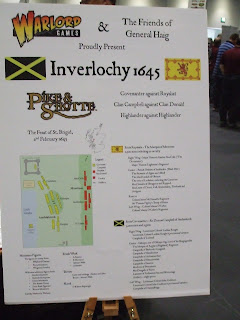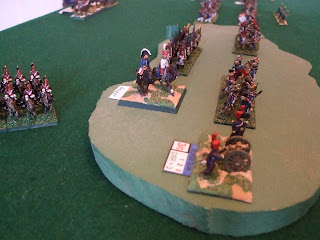Last year, my post on my first trip to Salute ended by saying that, enjoyable as it was, it was unlikely I would attend the show for a few years. Well, due to Mr Branson's munificence Steve and I ventured south once again. (with the travel costs being less than half what they had been in 2016, it would have been churlish not to take advantage!).
Once again the journey was swift and uneventful and by 9.30 we were helping set up the Lance and Longbow stand. There was time during the day to wander around and make those planned (and unplanned) purchases. My impression was that in spite of the number of visitors there was plenty of space to view the games, a high percentage of which were participation games. This has to be a good thing. Not only to attract new 'blood' into the hobby, but also allow established gamers to try out a rule set/period, before splashing out on rules and figures. Some of the trade stands were attracting considerable interest, with people queueing to make purchases, so hopefully it was a worthwhile trip for the traders.
Overall, I think the Sci Fi/Fantasy quota was down on last year, nor were there any of the large 'diorama/display' type games which attracted so much attention. Given the size of the venue if someone (club or group of individuals) can stage such a spectacle I am sure it would be a good 'draw'.
Here are some photos of the show, other blogs will already have posted their far more numerous offerings, but I hope this selection will give a flavour of the event.
Wyre Forest Wargames Club's 'Kalisz 1706'. The quality and detail of the painting of these 6mm figures was inspiring.
Raphia 217BC by Simon Miller and the Wargames Holiday Centre. The blocks of pikemen were very impressive.
One of several games based on the Russian Civil War, this one was 'Carry on up the Volga' by the League of Gentlemen Anti-Alchemists.
This ECW game attracted quite a bit of attention and used the 'Pike and Shotte' rules.
Essex Warriors put on this very impressive SYW game, the Battle of Prague. I would have liked to get back to this later in the day to see how the battle developed.
This 15mm Napoleonic 'Dresden' caught the eye, and one in 25mm by the Old Guard.
An often overlooked campaign, the Italian Front in WW1 by the Scarab Pals.
The modelling on this Samurai game by Oshiro Modelterrain was excellent. Although not games, I felt I had to take photos of these terrain features created by 4ground.
Certainly gave me a few ideas of what to aim for when building some defensive features for my Muscovites. This frozen landscape was also impressive
Also very impressive was the terrain for the 'Freebooters Fate' game
I had originally planned to restrict my purchases to sufficient figures to make up a unit of dismounted dragoons to supplement my French Grand Alliance forces. However, in my wanderings I found the 'By Sword and Flame' stand. Although I have 25mm armies for that period, the rule book and its supplements do provide loads of information on organisation etc and so I also left London clutching the revised rule book. A pricey purchase but one which I anticipate will help me get historically accurate forces together for my Eastern Renaissance games
The big plus of a show like Salute is the opportunity to meet up with friends/acquaintances who you rarely get the chance to meet in person. Neil, Rollo and Barry worked with Steve and I on the society stand and Bill, Jim and Ben did a great job with their participation game, with a good number of youngsters trying out their modified 'Lion Rampant' rules.
Some things don't change, the light levels, the noise and the hard floor (none of which the organisers can be held responsible for), but Salute is an excellent show, giving a gamer a chance to see the widest range of wargaming 'stuff' in the flesh rather than online.
1st Foot Guards 1685
21 hours ago




































